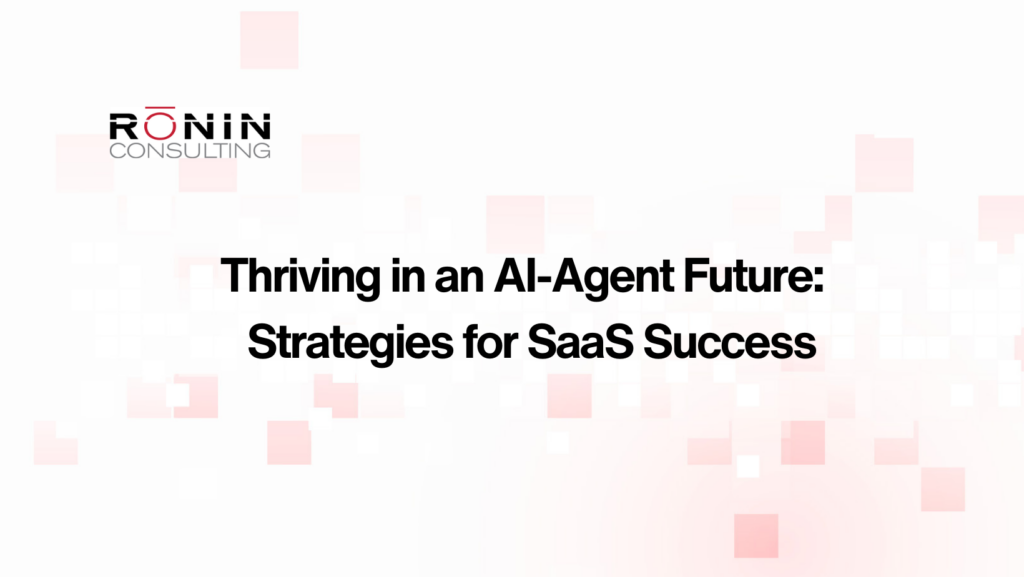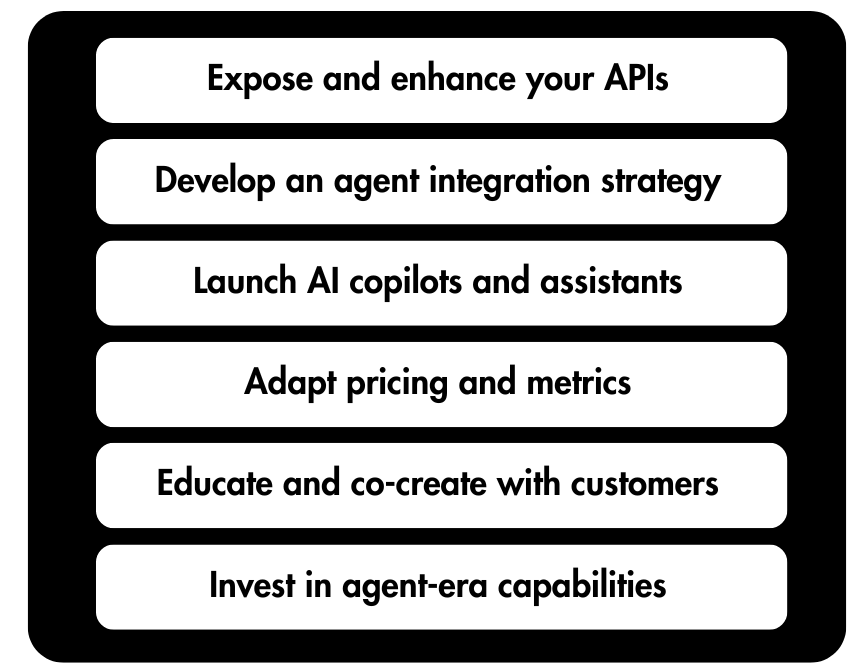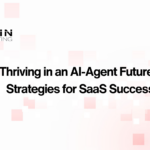
Thriving in an AI-Agent Future | Strategies for SaaS Success
The AI agent future is here, and these AI agents are reshaping the SaaS businesses and, fundamentally changing how software is used, integrated, and valued. As we explored in Part 1, AI agents are no longer just tools; they are becoming the users, shifting the focus away from traditional interfaces. In Part 2, we broke down the emerging AI Agent Stack, showing how SaaS must adapt to stay relevant in this new ecosystem.
Now, in Part 3, we shift from theory to action.
How can SaaS companies stay visible, competitive, and indispensable in an AI-driven world?
The key lies in rethinking your role—not just as a software provider but as a critical piece of the AI value chain. In this final installment, we’ll explore four strategic approaches for thriving in this AI-agent future:
- Becoming indispensable infrastructure – ensuring your APIs and tools are AI-ready.
- Embedding intelligence – integrating AI into your product to enhance user and agent experiences.
- Owning a piece of the control layer – building orchestration capabilities for AI-driven workflows.
- Balancing human and agent experiences – designing for both traditional users and autonomous AI.
SaaS companies that adapt now will define the future. Let’s dive into how your SaaS business can survive and thrive, in the AI-agent era.
Become indispensable infrastructure (tool/API provider).
Your SaaS should ensure it offers robust APIs or other machine interfaces because agents will be operating on behalf of humans and need programmatic access. A product that is not easily accessible to an autonomous agent will be skipped. Forward-thinking SaaS companies are already moving this way. For example, Stripe maintains a world-class API for humans and machines alike. They also built an infrastructure for AI consumption alongside their human-facing app to stay competitive.
This dual approach – one product for human users and one for agent use – might become the standard. SaaS firms should evaluate how to expose every significant feature via API or plugins, even those that historically required a GUI. By positioning themselves as the best “tool” in a particular domain, a SaaS can ensure agents favor it for tasks, preserving usage.
Embracing the infrastructure/tool role means that a SaaS must let go of the notion that users must see your interface. Some vendors fear losing customer engagement if automation replaces their UI. But trying to trap users in your UI is a mistake.
In practice, this might also involve offering new integration formats (e.g., being part of popular agent frameworks, providing SDKs, supporting open agent standards) so your SaaS becomes a default building block in AI-driven workflows.
Embed intelligence or provide it.
SaaS companies can also move into the intelligence layer by deeply infusing AI into their products. We can already see instances of this with the recent wave of built-in assistants (e.g., Salesforce’s Einstein GPT and Adobe’s Firefly in Photoshop).
Offering an AI copilot inside your SaaS can serve two purposes: it makes your product AI-enhanced for end-users and trains the company to operate an LLM in its domain. Over time, a SaaS provider could develop proprietary models or fine-tuned AI that become its own competitive advantage.
For instance, a SaaS with years of specialized data might fine-tune an AI that outperforms general models for specific tasks. This could effectively become a niche “intelligence” provider in its domain.
Moreover, AI-first design is key. Rather than bolting AI on as an afterthought, rethink your application as if an AI is a primary user. Ask yourself these questions:
- How would you redesign workflows so an agent can easily navigate them?
- Are there internal optimizations or data pipelines you can expose to AI?
- Can you structure your application to seamlessly collaborate with AI, allowing it to make proactive decisions and enhance user interactions?
SaaS teams should refactor rigid logic into AI-accessible modules. This might mean transitioning some functionality from code-based rules into model-driven policies that an agent can adjust. As a venture technologist advised, “Companies must evolve from traditional architectures to AI-first platforms, enabling agents to interact seamlessly with their tools.”
Own a piece of the control layer.
Another strategy is to build the agent or orchestrator for your domain. Suppose your company has deep domain knowledge (say, project management or marketing operations). In that case, you might create an AI agent that orchestrates tasks in that domain, essentially offering “X- Automation-as-a-Service” powered by AI.
This move is risky but potentially disruptive: it means moving from being one SaaS tool among many to being the brain that coordinates multiple tools (including possibly your competitors’ tools!).
For example, a SaaS project management company could release an AI agent that takes high-level project goals and automatically uses Jira, Confluence, Calendar, Slack, etc., to execute the plan. Doing so, you reposition from a tool provider to a workflow orchestrator for that vertical.
Incumbents with broad product suites are exceptionally well-placed here. They can integrate an agent across their ecosystem (e.g., Microsoft’s 365 Copilot spans Office apps). However, startups are also attempting this in niches, essentially launching “agent-native applications” that directly compete with legacy SaaS by abstracting them.
This move represents a significant shift, transforming the traditional service-as-software model—where software provides a service—into something entirely new. However, not every SaaS will pursue this, but it’s worth chasing if your core value could be delivered as an autonomous agent that works on the customer’s behalf. Even if you don’t build the agent brain from scratch, ensuring your product can plug into popular agents as a trusted executor will be necessary.
Maintain dual experiences: human and agent.
In the near future, leading SaaS companies must offer two seamless experiences: a refined user interface for humans and a machine-accessible interface for AI agents. Just as web apps had to evolve with APIs for mobile integration, AI now demands a similar shift. As seen with Stripe’s AI Agent model, industries must recognize and adapt to this emerging duality.
This shift might mean SaaS companies investing in things like AI-specific documentation, sandbox environments for agents, or even a “virtual assistant mode” of their product. While this is operationally complex, it buys time to serve current customers while preparing for the agent-dominated future. It also keeps your SaaS in the loop regardless of whether the end-user is a person or an AI.
Opportunities for incumbents and startups
Both established SaaS companies and new startups have opportunities in this agentic future, though their playbooks differ.
For incumbents
Incumbent SaaS firms have assets to leverage – data, customer trust, and domain experience. These can translate into durable positions if used wisely. One significant advantage is the proprietary data context. An AI agent finely tuned to a company’s unique dataset and workflows delivers exclusive value that competitors can’t easily replicate or monetize.
An enterprise SaaS with years of accumulated domain knowledge can build an agent that performs in ways a generic tool cannot. Incumbents should double down on their data moats. For example, a CRM company can train AI models on its own aggregated (and privacy-compliant) sales interactions to offer insights that no generic CRM API ever could. They can also provide enterprise-grade assurances such as security, compliance, and reliability for AI integrations, which many CIOs will demand.
Incumbents can turn this threat into an opportunity by introducing their own agent platforms. We have already seen early moves here: Salesforce with its AI Cloud and Einstein agents, Microsoft with its Copilots, etc. An incumbent could offer an agent that prefers its own suite of tools, creating a ripple effect across their products.
They also have existing distribution: they can bundle AI capabilities into their plans, upsell AI features, and educate their large customer bases on using these new tools. Far from being destroyed by AI, an incumbent who adapts can strengthen customer lock-in by becoming the orchestrator of how work gets done on their platform.
However, there is a note of caution here. Incumbents will face an innovator’s dilemma. Today, their revenue often comes from seat licenses and the human usage of their apps. Shifting to agent usage (potentially fewer human logins) might upend their monetization. To account for this, they must navigate pricing models for AI usage.
Despite these challenges, the cost of inaction is higher, and applications that don’t adapt might face declining usage – regardless. Like the companies that failed to go mobile, those who ignore the agent trend risk becoming the next cautionary tale.
For startups
The AI-agent wave is a classic platform shift for new entrants that levels the playing field. Startups are not burdened by legacy UI or business models – they can build an AI-native from day one. One clear path for these startups is identifying niches or vertical workflows that big SaaS companies poorly serve and creating AI agents to automate them.
For instance, a startup could build an agent specializing in real estate lease management or biotech research assistance – domains where incumbents are slow to adapt. By delivering tangible results (time saved, higher output) rather than just software, these new businesses can win customers who care more about outcomes than brand names.
Startups also have the chance to build a new agent ecosystem. Every new technology wave creates demand for supporting tools. We can anticipate needs like agent monitoring and observability, security layers, and interoperability standards. Just as past SaaS eras gave rise to monitoring tools and integration platforms, this agent era will need its tooling.
Finally, startups can aggressively align with the new value chain. They can skip building full-stack apps and instead focus on being the best at one layer. They can also pursue creative business models – for instance, usage-based pricing for tasks completed or success-based fees – essentially selling results rather than software seats. This aligns well with how an agent delivers value.
Both incumbents and startups should recognize that this isn’t a zero-sum game of AI agents versus SaaS. It’s about those who leverage the change versus those who resist it. The pie will continue to grow with new capabilities, but slices will be redistributed. In many cases, partnerships between incumbents and startups (e.g., an old-guard company adopting a startup’s agent framework) could accelerate adaptation on both sides.
6 practical steps for SaaS companies
Adapting to an AI-agent-driven future can feel abstract, but here are practical steps these companies should take now to position for this future:
Expose and enhance your APIs
Make sure every key function of your product is accessible via API (or other machine interface) and prioritize API robustness and documentation. AI agents are going to drive demand for APIs through the roof. Audit your API coverage. If features are only available through the UI, ensure they are accessible via API as well. Consider joining integration hubs or agent marketplaces to increase your visibility to AI developers. Evaluate how effectively agents interact with your API.
Identify potential obstacles such as rate limits, authentication challenges, or output formats hindering machine consumption. Optimize these aspects to ensure a seamless, agent-friendly experience.
Develop an agent integration strategy
Decide how your product will plug into the agent ecosystem. This could mean building a plugin for popular AI platforms (for example, a ChatGPT plugin that interfaces with your SaaS) or offering pre-built connectors for automation tools. The goal is to reduce friction for any AI agent using your service. Begin to treat agents as a new class of customers and court them by making integration easy. Some companies are creating agent SDKs or libraries to simplify how external developers can incorporate their SaaS functionality into agent workflows.
Launch AI copilots & assistants
Integrate an AI assistant within your UI to augment your human users. This serves a dual purpose: it differentiates your product today and builds your internal AI competencies. These copilots can also handle multi-step tasks internally, functioning as mini-agents within your app. By doing this, you keep your UI relevant (users enjoy new AI-driven features) while ensuring that if a user’s AI agent is using your app, it can potentially interface with your AI assistant (agent-to-agent communication).
Adapt pricing and metrics
Begin to shift how you measure and charge for success. If historically, you charged per seat or per active user, you might consider usage-based pricing to capture value from agent usage. Monitor metrics like a number of API calls by agent systems, tasks completed via automation, etc. This will help you understand adoption in the new model.
It also signals to customers that you’re aligned with their AI automation goals (e.g., offering an option to pay for outcomes or usage, not just logins). So, adapt your business model to incentivize and monetize heavy usage, regardless of whether it comes from people or AI.
Educate and co-create with customers
Many customers (especially enterprises) will be cautious about AI agents. SaaS providers should proactively help them integrate AI workflows with your product. This might involve publishing guides or best practices for using AI agents with your SaaS.
This could also mean working closely with pilot customers to build successful agent integrations – a consultative approach to ensure your SaaS fits into their AI-driven processes. By doing this, you make your product stickier and learn real-world usage patterns to refine your offerings. You should also consider partnering with forward-thinking clients to create case studies. E.g., “X Company used our API and an AI agent to automate 50% of their workload – and here’s how.” Such stories will both validate your relevance and provide feedback for improvement.
Invest in agent-era capabilities
Finally, look internally at what new capabilities and talent you need. This could mean hiring ML engineers or prompt engineers to improve how your product works with AI. It might involve beefing up your infrastructure to handle an onslaught of API calls from agents working 24/7.
Consider building monitoring tools that track AI usage specifically – e.g., flag anomalous agent behavior or errors when an agent interacts so you can troubleshoot. Ensure your security model covers scenarios like an AI agent with API keys (you may need more granular permission scopes or rate controls to prevent mistakes at machine speed). Gear up your tech stack for “always-on” machine clients that will be there alongside human users. This groundwork will pay off as agent usage scales.
Embrace the change, don’t fight it
The rise of AI agents represents a fundamental shift in the software landscape, but it’s not a death knell for SaaS – it’s a call to evolve. As SaaS once disrupted on-premises software, SaaS companies must now reinvent themselves for the agentic age. Those who seize this moment will find new growth opportunities, whether by powering the brains of AI workflows or by automating outcomes for customers in unprecedented ways. Those that ignore it, clinging to old UX-centric models, risk becoming obsolete as AI-driven workflows route around them.
The urgency is real – but so is the opportunity. By rethinking strategies and repositioning within the AI agent ecosystem, SaaS businesses can ensure they remain relevant and essential in the future of software.
Adaptation is the only path forward. The agent era will reward companies that provide value in whatever form – UI, API, or AI-driven service – and punish those that rigidly stick to yesterday’s playbook. Embrace the coming changes with an open mind and a proactive plan, and you can turn disruption into a new chapter of growth for your SaaS business.






